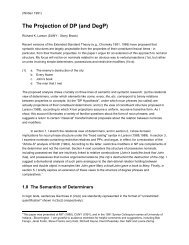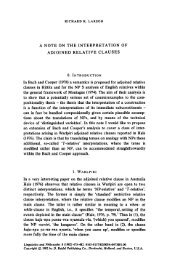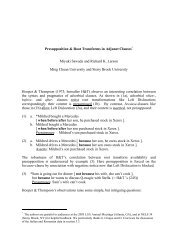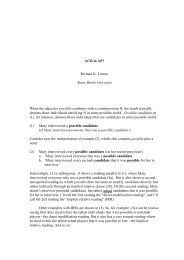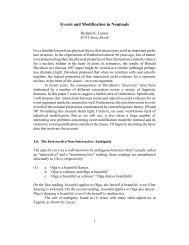Intensional Transitive Verbs and Abstract Clausal Complementation
Intensional Transitive Verbs and Abstract Clausal Complementation
Intensional Transitive Verbs and Abstract Clausal Complementation
You also want an ePaper? Increase the reach of your titles
YUMPU automatically turns print PDFs into web optimized ePapers that Google loves.
<strong>Intensional</strong> <strong>Transitive</strong> <strong>Verbs</strong> <strong>and</strong> <strong>Abstract</strong> <strong>Clausal</strong> <strong>Complementation</strong><br />
(53) a. Max needs no bananas<br />
b. Max needs to have no bananas<br />
Although syntactically very close on our analysis, (53a) <strong>and</strong> (53b) diverge in meaning. Consider the<br />
situation where Max actually gets (<strong>and</strong> therefore has) bananas. (53a) has a reading on which Max’s<br />
needs are met in these circumstances: he doesn’t need any bananas, but he gets them anyway. By<br />
contrast, (53b) has no reading on which Max’s needs are met in the situation described. What (53b)<br />
asserts Max to need is that he have no bananas.<br />
A similar effect arises with object NPs containing at most:<br />
(54) a. Max needs at most five bananas<br />
b. Max needs to have at most five bananas<br />
Consider the situation where Max actually gets (<strong>and</strong> therefore has) six bananas. Max’s needs as<br />
expressed by the salient reading of (54a) are met in these circumstances: he doesn’t need more than five<br />
bananas but he gets them. But Max’s needs as expressed by (54b) are not met in these circumstances.<br />
What he needs is to have at most five bananas, <strong>and</strong> his needs are not met if he gets six. Zimmermann<br />
(1993) takes the contrast between (53a)/(54a) <strong>and</strong> (53b)/(54b) to show that there is no derivational<br />
relation between intensional transitive need <strong>and</strong> clausal complement need, <strong>and</strong> hence that the two require<br />
a different syntax <strong>and</strong> distinct semantics. We believe this conclusion is hasty however. We will now sketch<br />
an alternative, clausal approach that not only gets the facts in question but others besides.<br />
The basic insight of our alternative is due to Klima, who proposed in a classic paper (Klima (1964))<br />
that negative NPs of the form no-N divide into two separate components: a sentence negation <strong>and</strong> an<br />
indefinite. Klima’s point was suggested in connection with the equivalence of (55a) <strong>and</strong> (55b). One way of<br />
spelling out Klima’s proposal concretely is to think of (55a) along the lines of (55c), where the negative<br />
determiner decomposes into an abstract sentence negation NEG together with an indefinite word no<br />
having the force of any. 29<br />
(55) a. Max had no bananas<br />
b. Max didn’t have any bananas<br />
c. Max NEG had [ t no ] bananas<br />
\______/<br />
We may assume the NEG to raise to the position of sentential negation at LF. Ultimately, then, (55a)<br />
possesses a form analogous to (55b), namely, (55c).<br />
In general, NEG V...any-N is equivalent to V...no-N. There is one prominent place where the<br />
equivalence fails, however. This is the case where more than one sentence is present (more than one<br />
clause), <strong>and</strong> hence more than one potential location for sentential negation. (56a) is equivalent to (56b),<br />
but not to (56c).<br />
28 This argument is repeated in Moltmann (1997).<br />
29 See Ladusaw (1992) for a related proposal.<br />
23



